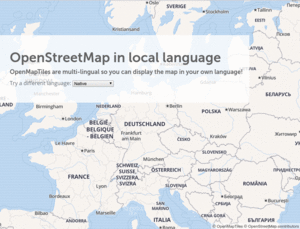OpenMapTiles
| OpenMapTiles | ||||||||||||||||||||
|---|---|---|---|---|---|---|---|---|---|---|---|---|---|---|---|---|---|---|---|---|
| Author: | MapTiler and other contributors. | |||||||||||||||||||
| License: | BSD | |||||||||||||||||||
| Platforms: | Windows, Linux, macOS, and Docker | |||||||||||||||||||
| Website: | https://openmaptiles.org/ | |||||||||||||||||||
| Source code: | https://github.com/openmaptiles | |||||||||||||||||||
|
OpenMapTiles using the MapTiler Streets style |
||||||||||||||||||||
| ||||||||||||||||||||
OpenMapTiles is an open-source project aiming to create world maps from open data. It consists of a set of tools allowing everyone to create their own vector map tiles from OpenStreetMap data for hosting, self-hosting, or offline use. It is available as free software on OpenMapTiles.org. There is also a spin-off project called MapTiler Data with ready-to-use pre-generated map tiles and MapTiler Cloud for map hosting.
OpenMapTile is a successor to OSM2VectorTiles.
Components
The OpenMapTiles project consists of several components:
Schema
The schema describes data layers and attributes. It is maintained in the openmaptiles repository and documented on the website.
Tools
The openmaptiles-tools repository contains tools for taking OSM data as an input and producing MBTiles containing PBF as an output.
Styles
Open Map Styles are ready-to-use map styles for vector scheme. They are available under a free license and therefore can be modified and reused.
Features
Displaying map
The final map can be displayed in the browser using most popular JavaScript libraries like Mapbox GL JS, OpenLayers, Leaflet, in mobile applications using Mapbox GL Native (for both Android and iOS), using WMTS and WMS services, or as a static map for print and export.

Languages
OpenMapTiles supports more than 50 languages. The names are taken from OpenStreetMap and enhanced by adding data from Wikidata. There is an option to display names in a selected language, a native language for each country, or a combination of the selected and native language.
Styling
The big advantage of vector tiles is the separation of data and styles. Therefore it is possible to use the same data with more styles, which can be adjusted on-the-fly.
OpenMapTiles use Mapbox Style Specification, where a style is a JSON object.
{
"id": "building",
"type": "fill",
"source": "openmaptiles",
"source-layer": "building",
"minzoom": 4,
"paint": {
"fill-color": "#ccc",
"fill-outline-color": "#333",
"fill-opacity": 0.5
}
}

The style can be edited in any text editor or visually in Maputnik, an open-source visual style editor.
Supported coordinate systems
OpenMapTiles also supports other coordinate systems than Mercator. The result is compatible with JavaScript viewers, mobile SDK, as WMTS or WMS,
MapTiler Server
MapTiler Server is a software package for Linux, Windows, and Mac. The setup is easy and straightforward; you can serve OpenStreetMap from your own hardware in less than 10 minutes.
Installation
There is a single file installer for Linux, Windows, and Mac.
Once installed, you can insert map data and map styles into relevant folders. In the web interface you define which datasets will be served and you will get links to all map services for usage in Leaflet, OpenLayers, Mapbox GL JS and WMTS for QGIS and ArcGIS.
MapTiler Data
Since rendering one's own tiles is time and resource consuming, MapTiler Data offers pre-rendered tiles of the entire world.
There is a free plan for open-source and open-data websites, non-commercial personal projects, and testing purposes. There are also paid plans, which come with premium styles, hillshading, contour lines, a terrain model, and satellite imagery.
Tiles can be selected by regions, countries, continents, or the whole planet. There is also an option for extract defined by bounding box.
MapTiler Cloud
MapTiler Cloud provides hosting of map tiles based on OpenMapTiles. It provides vector tiles (for Mapbox SDK, native MVT clients) as well as raster tiles (Leaflet, OpenLayers, XYZ), map WMTS services for QGIS and ArcGIS and static maps for thumbnailing or output printing.
The policy is similar to MapTiler Data: there is a free plan for non-commercial and testing purposes as well as the paid one.
The whole service is cached on CDN with more than 150 places. The core runs in three fully redundant datacenters in Europe and North America, which have DDOS protection and load-balancers with failover and more.
Attribution
OpenMapTiles requires attribution on screen in the form "© MapTiler © OpenStreetMap contributors", see their terms.
Source code
OpenMapTiles is developed by the MapTiler Team and available as free software under a combination of BSD and MIT licenses.
It is the successor of OSM2VectorTiles, which was a student bachelor thesis at HSR Rapperswil.
The source code is available on GitHub.
Bug reporting
Bug reports, as well as other issues, should be reported through the GitHub repositories.
